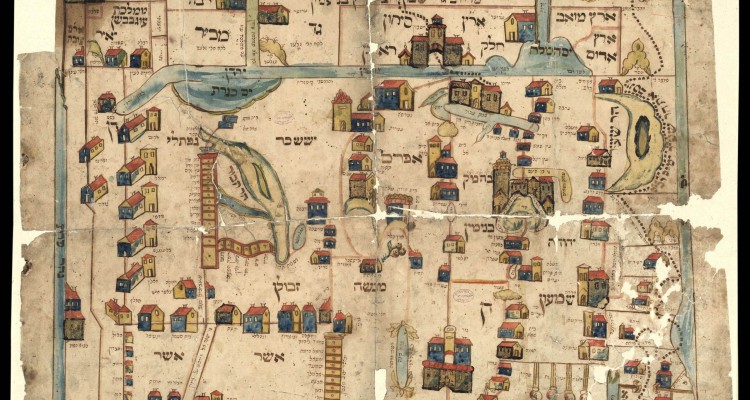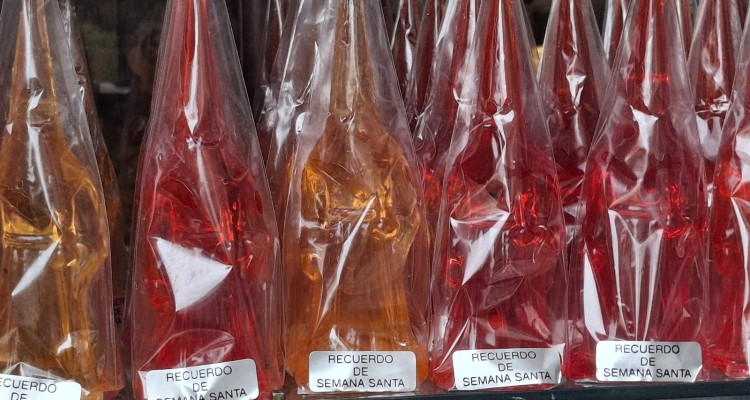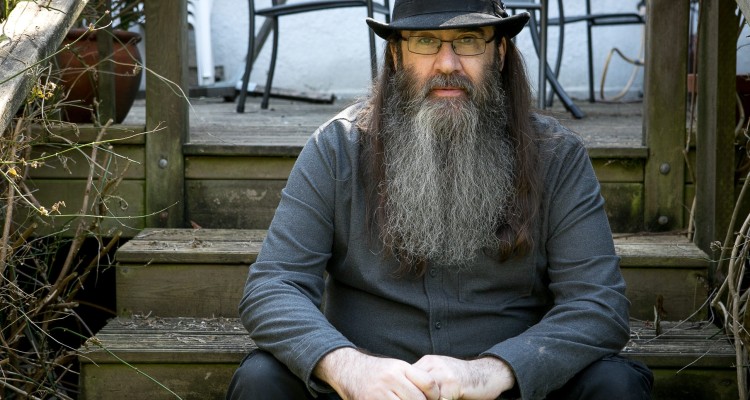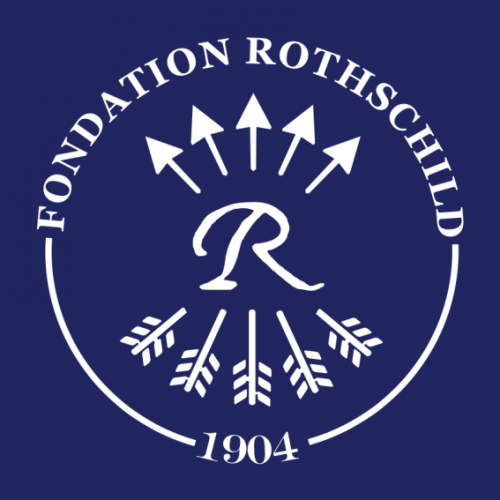“My novels are a kind of Litvak saga, a monument to the memory of the Lithuanian Jews who have passed away. This is how Grigory Kanovich likes to describe his work. Born in June 1929 in Janova to a Yiddish-speaking Jewish family, he has published many short stories and ten novels, translated into many languages. Last August, in the form of a four-part serial, K. published the first French translation — by Elena Guritanu — of “Poor Rothschild”. At the beginning of this year, we continue the Jewish saga of this prolific 94-year-old Lithuanian writer with the story “I dreamed of Vilnius, the lost Jerusalem”, written as a tribute to Wilno, the Jerusalem of Lithuania. In the preface to this reading, Elie Petit and Elena Guritanu retrace his journey for K.
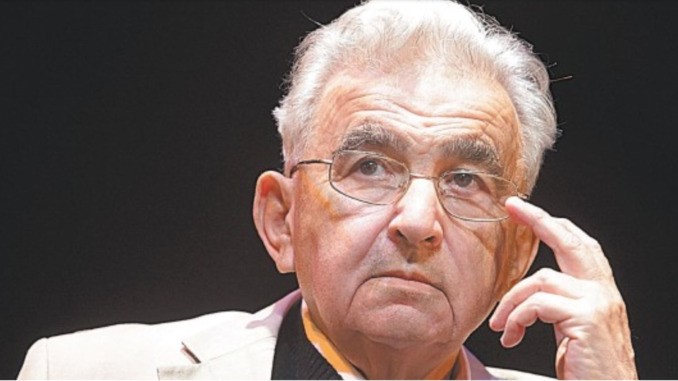
The Jewish presence in Lithuania spans over 600 years. Settled first in Vilna, and a century later in Kaunas, Lithuanian Jews formed an organised community as early as the 16th century. This presence was so deeply rooted in the Lithuanian geographical and cultural territory that one of its former autocratic presidents, Smetona (whose name is adopted by a secondary character in “Poor Rothschild“) spoke Yiddish…
Protected by the Grand Dukes of Lithuania, and later by the kings of Poland, the Jewish communities of Lithuania played an important economic role from the Middle Ages onwards. Until the 17th century, when the first anti-Semitic episodes took place, the Vilna synagogue was destroyed during a riot in 1635, and between 1653 and 1663 several professional bans were imposed on Jews, the Jews led a peaceful and prosperous life.
At the height of its power, the Grand Duchy of Lithuania included the territory of present-day Lithuania, Belarus, parts of Ukraine, Russia and Latvia. Even after its annexation by Poland in 1569, Jews retained a strong attachment to this Lithuanian home, both one of the centers of gravity of Judaism and one of the cradles of a secular Jewish culture in the Yiddish language[1].
“In Jewish historical memory, Lithuania – in Yiddish, Litè – still stretches from Brest and Grodno to Starodub and Chernigov, and its borders are defined by the extent of Litvish, the Lithuanian dialect of Yiddish, the soil on which the standard Yiddish – the klal shprakh – of the modern period (which became the literary language of the twentieth century) was built. ‘It was the language, therefore, that formed the substratum of this historical memory,’ writes Mikhail Krutikov, a specialist in Slavic studies and a lecturer at the University of Michigan, in his preface to a Russian edition of the Selected Works of Grigory Kanovich[2].
Ethnic Lithuania, a relatively small part of the former Grand Duchy of Lithuania, had its own Jewish name: Zamut[3], derived from Lithuanian Žemaitija and Russian Жмудь (Zhmud).
The protagonists of Grigory Kanovich’s stories came from Zamut. Like Faulkner, Kanovich created his own imaginary territory there, populating it with characters from his own childhood – mainly ordinary Jews, but also Lithuanians, Poles, Belorussians and Russians. Published in 2010, “Poor Rothschild”, set in a shtetl, is a testament to a part of this world that unfolds in a dozen novels. Together they form an epic saga, haunted by the Shoah, dealing with the vicissitudes of Eastern European Jewish history from the 19th century to the present day.
***
On the eve of the German breakthrough in Lithuania, at only ten years old, Kanovich fled to Kazakhstan and the Ural Mountains where he spent several years with his parents. When Grigory Kanovich, the future author of the Lithuanian Jewish saga, returned to Vilnius, he was 16 years old. Wilno, the Jerusalem of Lithuania, which he had left in a hurry in 1939, took up all the more space in his adolescent imagination as it was nourished during those years of painful separation by the stories of his relatives and their memories, their uprooting gave an air of legend. But it is no longer the story-telling town of his childhood that he finds, following in his mother’s footsteps with fear. There is an absence. The ruins of a Jerusalem that hides under heaps of snow the tragedy of a murdered people. Kanovich will never cease to reconstitute the memory of these beings who disappeared in the earthquake of the Shoah, not to offer them a burial but to inspire them again with a breath of life and, with them, to rebuild with fiction the pre-war Lithuania and its Yerushalayim.
His first autobiographical short story, I Look at the Stars, was published in the Soviet Union in 1959. This was followed in 1967 by the short story Personal Life, then the trilogy Candles in the Wind, the first volume of which was published in 1974.
For Mikhail Krutikov, Kanovich is a realistic novelist. “The action of each of his works takes place at a specific moment in history, the details are precise and authentic, and if the characters are incarnate, made of flesh and bone, it is because they are often modeled on men and women whom the author has really met (…) But at the same time, the reader is left with a sense of unreality. Where and when did all this happen? Was it really real? And where is this world now? Grigory Kanovich is our only guide in the totally erased world of Lithuanian Jews.
Kanovich is in fact not the only author who has undertaken the task of evoking Lithuania’s Jewish past. Chaim Grade, Avrom Sutzkever and Abraham Karpinovich come to mind. But they wrote in Yiddish. Kanovich, on the other hand, writes in Russian, which is not one of his two mother tongues. The strange originality of his work therefore raises questions. One of his publishers, Borukh Gorin, addresses this question: “Grigori Kanovich is a Jewish writer. No, it’s not that, Grigori Kanovich is a Lithuanian writer. Wrong. Grigory Kanovich is a Soviet writer. No, he is not. Grigory Kanovich is an Israeli writer[4]. No, he isn’t. He is all of these at once and none of these taken separately. Kanovich is a hyphen between several times. He thinks of pre-Soviet, Soviet and post-Soviet Lithuania. He grew up with his Jews, he saw their disappearance into the abyss. They are not his characters, they are his relatives. He himself is one of them. A survivor to bear witness. He reaches out to them and gives them back their names. His books are a giant testimony[5].”
Kanovich’s approach of displacing Jewish literature in Yiddish and transplanting it into Russian literature is thus his singularity. And the author says: “In my opinion, there are no Russian Jewish writers, let alone Russian-speaking ones. A Russian author who writes about Jewish themes does not have to ask himself which literature he belongs to. If he does not belong to Russian literature, in my opinion, he is worthless. When you write in Russian without being a Russian writer, you are rejected in your own house, so you are not a writer.[6]”
Jewish, but Russian-speaking[7]… For Krutikov is keen to point out Kanovich’s perpetual exchange with specifically Jewish literature in Yiddish: ‘Unique among contemporary Russian-Jewish writers, Kanovich is at the same time engaged in an active dialogue with [it] and, above all, with the work of Peretz. The Jewish dimension is set at the turn of the twentieth century, in a context of pogroms, revolution and vilification, and leads inevitably to the theme of the Shoah, questioning the meaning of memory and time. To simplify a little, one could say that in all of Kanovich’s work, his venerable characters, with ambiguous personalities full of contradictions, inclined to reflection and introspection, find themselves in a Peretzian situation, between two worlds, between the living and the dead, alone with their memory. […] The reader will find here bloody and richly detailed images of life in the Jewish villages and towns of Lithuania, which do not and will not appear in any other literature[8].”
A unique writer, Kanovich is also unique in belonging to a singular Soviet republic, as Krutikov reminds us: ‘Among all the Soviet republics, it was only possible to publish books in Russian on Jewish themes in Lithuania, under the cover of the Union of Local Writers. However, because of his background and linguistic skills, Kanovich was an insider among the Lithuanian intelligentsia and the publication of his books was a form of rebellion against Moscow – or so it seemed from the Soviet capital, where the writer’s Lithuanian publications were not available for sale. During the Soviet era, if Kanovich wrote about modernity, he did not usually deal with Jewish themes. The obvious reason for this choice was censorship, but the deeper reason was the nature of his writing. Kanovich always writes about the past rather than the present, a past that contradicts the official memory. Lithuania’s recent history has seen three moments of historical amnesia: the October Revolution and the creation of independent Lithuania; the Second World War, with the Soviet occupation and extermination of the Jews; and the restoration of independence in 1991. Each of these moments is accompanied by a radical revision of the past, the erasure or rewriting of its pages. Kanovich has always resisted this ‘weeding out of history’, in the words of one of his characters[9].”
In an interview with Baltic Worlds, Kanovich describes his situation and the evolution of his readership as follows, “Living under the Iron Curtain, my main readers were Russian-speaking Jews, in general. But they were not the only ones. I wrote about half of my Litvak saga novels while living in Israel. I tried to create a monument to my lost compatriots, that was my mission. In the Soviet Union, I tackled the subject of the fate of the Jews under the anti-Semitic Tsarist empire – this is probably why the censors of the Soviet empire thought that the ideas and values I was defending were harmless[10].” Harmless and yet committed: Kanovich would become the first president of the Lithuanian Jewish community, a member of the independence party and a deputy in the last Supreme Soviet.
***
The recipient of numerous national and international artistic awards throughout his career, Kanovich now lives in Israel. K. magazine thanks him and his sons for their trust. His son Sergey is the director of a museum under construction, the Lost Shtetl Museum, which will open in 2024. K. will not fail to cover the emergence of this project, whose ambition is to recall the history of the Jews of Seduva and to tell the folklore, cultural, social, religious and economic life of the Lithuanian shtetl, from their origin until their extinction.
Like most of Grigory Kanovich’s texts, The Poor Rothschild offers us an x-ray vision of the Lithuanian Jewish community in the first half of the last century, on the eve of the Second World War. It evokes a vanished world and society to which the author wants to pay tribute. Kanovich’s colourful and picturesque characters, dreaming of an elsewhere but always confronted with hardships that stand in the way of their dreams, could be those of a Yiddish tale; until the moment when history catches up with them.
Itsik Rothschild, the central character of the story, encouraged by his two protectors, Rabbi Hillel and the pharmacist Zalman Amsterdamskii, also has dreams of emancipation. His quest: to find the Rothschilds of Paris or London, to whom he is supposedly related, in order to gain access to a better future. But his aspirations are as contradictory as they are contradictory, for he is deeply attached to his environment, to his simple life as a bath boy and to his sick father whom he cannot abandon. He would sometimes like to break the boundaries of his restricted world and leave the shtetl, but he finds it difficult to fully accept this desire and to separate himself from the world he loves and of which he is an unshakeable part. It is reality and history itself that will overcome this ambivalence…
Elena Guritanu and Elie Petit
Ici : “Pauvre Rothschild”, episode 1.
Notes
| 1 | the intellectualist current emerged in Vilnius in the mid-18th century, as well as the socialist workers’ movement Bund |
| 2 | Mikhail Krutikov, “Пространство памяти Григория Кановича”, Избранные сочинения в пяти томах [“Grigory Kanovich’s memorial space”, preface to the 5-volume Selected Works], Tyto Alba edition, 2014. |
| 3 | , the Jewish name for a part of the principality of Lithuania, located on the middle and lower reaches of the Niemen River. |
| 4 | Grigory Kanovich emigrated to Israel in 1993, where he resides until this day. |
| 5 | https://www.lechaim.ru/ARHIV/262/dnevnik_redaktora.htm |
| 6 | http://magazines.russ.ru/voplit/2003/4/kanov-pr.html |
| 7 | Sensitive to the future of Lithuanian literature, Kanovich is also a translator into Russian of such classics as Balys Sruoga’s The Forest of the Gods, Bronius Radzevičius’s Paths of Dawn, Jonas Avyžius’s Time of Empty Farms. |
| 8 | Mikhail Krutikov, op. cit. p. 13. |
| 9 | Idem. |
| 10 | https://balticworlds.com/lithuanian-author-grigory-kanovich-survivor-of-the-shtetls |
